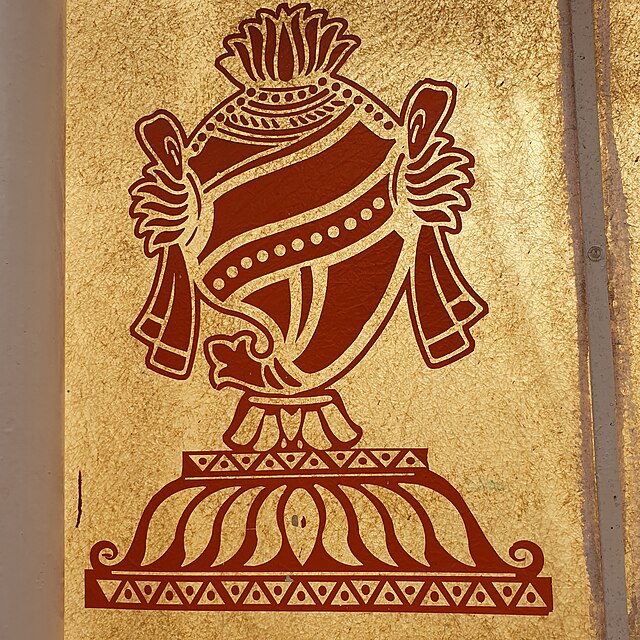Panchajanya
The conch of the Hindu god Vishnu From Wikipedia, the free encyclopedia
Panchajanya (Sanskrit: पाञ्चजन्य, IAST: Pāñcajanya) is the shankha (conch) of the Hindu preserver deity Vishnu, one of his four primary attributes.[1] The Panchajanya symbolises the five elements,[2] and is considered to produce the primeval sound of creation when blown.[3]

Literature
Summarize
Perspective
Mahabharata
According to the Mahabharata, Vishnu is stated to have slain a daitya (a member of a clan of asuras) named Panchajana on a mountain named Chakravan[4] constructed by Vishvakarma, and seized the conch shell in which Panchajana had lived for himself.[5] The conch is named after the daitya.
Bhagavad Gita
In the Bhagavad Gita, the Panchajanya is mentioned:[6]
Then, Lord Krishna blew His conchshell, called Pancajanya; Arjuna blew his, the Devadatta; and Bhima, the voracious eater and performer of extremely difficult tasks, blew his terrific conchshell called Paundram
— Bhagavad Gita, Chapter 1, Verse 15

Harivamsha
As per the Harivamsha, Krishna, the avatar of Vishnu, is described as possessing a conch shell called Panchajanya, one of his four attributes together with the mace Kaumodaki, the disc-like weapon Sudarshana Chakra, and a lotus.[7] The conch was used during the Kurukshetra War, and is held in popular tradition to have signalled its beginning and end.
Skanda Purana
The Skanda Purana features two origin legends for the conch.
The Panchajanya is mentioned to be among the various substances and beings that emerged during the Samudra Manthana:[8]
Then came out the Śārṅga bow, the presiding deity of all weapons. Then emerged Pāñcajanya, the conch, the supreme deity of all musical instruments.
— Skanda Purana, Vasudeva Mahatmya, Chapter 12, Verse 14
In another legend, Sandipani, the guru of Krishna, Balarama, Sudama, and Uddhava, states that his son was swallowed by a whale at Prabhasa while he was on a pilgrimage, and seeks his return as his dakshina (honorarium). The Ocean itself is stated to have informed Krishna of the existence of a great daitya of the name Panchajana dwelling in its depths, who indeed had swallowed the boy. Krishna slew the daitya who was in the form of a whale, and seized the Panchajanya from within him, which had previously belonged to Varuna. Not finding his guru's son, he descended to Naraka with Balarama and demanded his return. Yama and Chitragupta battled the deities until Brahma intervened, and urged Yama to restore the boy back to life. His desire fulfilled, Brahma eulogised Krishna, prompting him to blow his conch:[9]
The sound of the conch was conducive to the liberation of the men who had committed sinful activities and therefore had been consigned to hells. Due to the sound of the conch and the recollection of Acyuta, all of them got into divine aerial chariots and went to heaven. That region (of hell) became a void, due to the contact with Nārāyaṇa.
— Skanda Purana, Avantiksetra Mahatmya, Chapter 1, Verses 101 - 102
Krishna and Balarama then returned the son back to his father, who rejoiced in surprise and hailed their names.
References
Wikiwand - on
Seamless Wikipedia browsing. On steroids.
